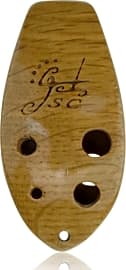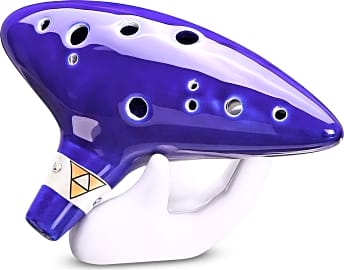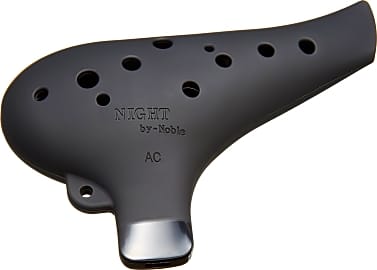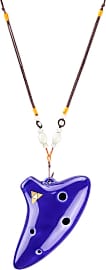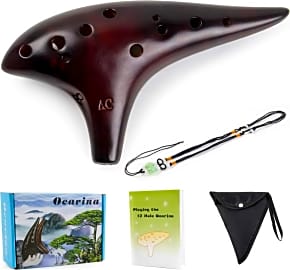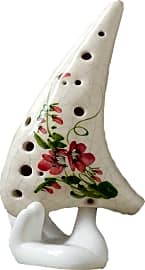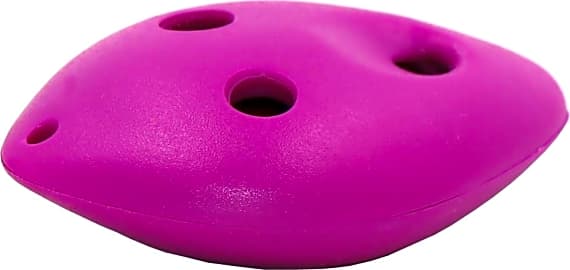The 10 Best Ocarinas

This wiki has been updated 43 times since it was first published in May of 2016. The ocarina belongs to an old family of instruments believed to date back over 12,000 years. Similar simple woodwinds have been of particular importance in Chinese and Mesoamerican cultures, where they've played a significant role in long histories of song and dance. If your interest is piqued, take your pick from our selection, which includes options for budgets of all sizes. When users buy our independently chosen editorial selections, we may earn commissions to help fund the Wiki.
Editor's Notes
April 11, 2020:
If you're looking to bring a fresh sound to your ensemble, or even if you're just on the hunt for an instrument that your kids can pick up and play easily, the ocarina is a good place to start. This wind instrument is relatively simple to learn. Most of the ocarinas we've featured in this list have twelve holes or fewer, which means they can be played by users with small hands, unlike most wind instruments. We've made sure to include options made from a variety of materials, such as wood, ceramic, and plastic. There are down-sized models that are perfect for traveling, in addition to traditional models crafted for professionals who play on frequent basis.
The Semli Ancient, Greentent LJS Children, Winterworm Elegant, and Aklot Set have been added to the list, chosen for overwhelmingly positive reviews that address both sound quality and ease of use. The Focalink Alto C, Miric 12 Hole, Professional Dragon Rythem 12 Hole, and Andoer Flute were removed due to availability concerns and confirmed complaints about quality.
Special Honors
JJ's Ocarina Kit If you're not looking for a professional-quality instrument but rather an activity for a youngster in your life, this is a good choice. It's an eight-piece three-dimensional puzzle that, once completed, can be played just like a real ocarina. The set comes in a retro tin container and is surprisingly affordable, and the song sheet and instructions are easy to interpret. tintoyarcade.com
Dobani Alto This highly portable model can be worn around your neck thanks to its stylish braided leather necklace. Made from molded clay and featuring a high shine finish, it has an attractive rustic appearance. It's designed to be played at a 45-degree angle from the mouth. musicalinstrumentshoppe.com
Grover FN152 Another classic sweet potato-shaped instrument, the FN152 is designed for users of all ages. It comes in a muted blue color and has a surprisingly clear tone given its reasonable price tag. It's approximately six inches long by four inches wide. walmart.com
A Brief History Of The Ocarina
Across the globe, ancient Mesoamerican societies developed their own takes on what is now called the ocarina.
The class of instruments to which the ocarina belongs is over 12,000 years old. Generally speaking, an ocarina is a small flute-like instrument, usually somewhat round in shape, with a mouthpiece or hole for air to enter through, and several smaller holes on its body through which air can flow out. The holes can be covered with one's fingers, allowing for the production of a variety of notes and chords.
Due to its relative simplicity, it is not entirely surprising that variations on the ocarina seem to have developed independently in many ancient cultures that had no contact with one another. The general category of instruments into which the ocarina falls is called "vessel flutes." A vessel flute is technically any container that produces sound when air or wind is blown across or inside of it. Remember when you first discovered that blowing air across the mouth of a glass bottle produces a sound? A glass bottle itself is technically a primitive form of a vessel flute.
The most notable vessel flutes from history that inform today's ocarinas include the Chinese xun and pre-Columbian Mesoamerican pendant models. More contemporary versions originate in Europe, hence the Italian name ocarina, which is applied widely and often retroactively to describe similar instruments from other cultures.
The Chinese xun has a 7,000-year history. It is typically egg-shaped and made of baked clay, ceramic, or hollowed bone. In addition to a hole at its tip which serves as a mouthpiece, it typically has at least three finger holes on its front and two for the thumbs on its back. Similar instruments were also developed in Korea and Japan.
Across the globe, ancient Mesoamerican societies developed their own takes on what is now called the ocarina. Some of these instruments were also worn on the body as pendants. The Incans, Aztecs, and Mayans typically formed these instruments out of clay and often fashioned them in the shapes of birds and animals. Ocarina-like instruments fashioned from gourds have also been recovered from archeological sites in Africa.
In Europe, proto-ocarinas called gemshorns have been fashioned from animal horns for centuries. The earliest examples were likely brought back to Europe from the exploratory missions to the Americas that began as early as the 1400s. However, there is evidence that ocarinas have existed on European soil for much longer than that, as one of the oldest known specimens was found in Kosovo . The neolithic-era stoneware instrument known as the Runik Ocarina is believed to date back nearly 8,000 years.
Ocarinas of varying styles had become popular children's toys in Europe by the 19th century. In 1853, a 17-year-old boy from a small town near Bologna named Giuseppe Donati fashioned his own version with 10 holes that could play a full scale of musical notes. This was the first model suitable for playing contemporary music, and so Donati's design became the industry standard. He also coined the term ocarina itself, which means "little goose" in Italian. His contributions have led many people to refer to Donati as the ocarina's inventor, despite the instrument's many thousands of years of history that predate him.
How Nintendo Brought The Ocarina Back Into Fashion
While it has remained in circulation throughout its global history, the ocarina was a relatively niche instrument in contemporary culture until the Nintendo corporation began including it in the mythology of its Legend of Zelda series of games in the 1990s. It first appeared in the 1991 Super Nintendo Entertainment System game The Legend of Zelda: A Link to The Past, as the "magic flute." It was an essential object to find and master in order to succeed in the game, though it did not get top-billing, nor was it recognized by name as an ocarina. However, that all changed when the object rose to much higher prominence in 1998 with the release of The Legend of Zelda: The Ocarina of Time for the Nintendo 64 system.
In The Ocarina of Time, the instrument played a pivotal role in the game. Players were required to learn and perform several songs on the in-game ocarina in order to make progress. The game retains a cult following and was immensely popular upon its release, breaking countless sales records and outperforming even many blockbuster Hollywood films released that same year. It remains one of the most highly regarded video games of all time, and its success sparked a huge renewed interest in ocarinas outside of the digital realm. After its release, many ocarina manufacturers found their business doubling seemingly overnight. The ocarina renaissance continues to this day, with no shortage of styles and designs to be found, both Zelda-inspired and otherwise.
How To Shop For An Ocarina
In addition to the 10-hole transverse style Donati invented, there are many popular variations on the ocarina today. A 12-hole style that can play a full scale octave is also common, as is a variety of models that draws on the various historical cultural traditions of vessel flutes from around the world. Like harmonicas, ocarinas are often given to children as a first musical instrument due to their small size and affordability. They can now be found made of materials ranging from plastic to stone, and nearly everything in between.
They can now be found made of materials ranging from plastic to stone, and nearly everything in between.
If you're shopping for a child, plastic might be a great place to start. Plastic ocarinas are durable and inexpensive, and can produce relatively pure tones given that they are precisely machined. For a more earthen feel, and perhaps a more natural sound, ocarinas made from stone or wood might fit the bill. The ceramic options tend to be a bit higher end, and many come with irresistible, eye-catching designs.
One other factor to consider is what style of mouthpiece is right for you. A model with an articulated mouthpiece might be easier for beginners to start with. Whatever you end up choosing, as long as you stick to the proper finger positions, you're sure to master a few classic tunes in no time at all.



